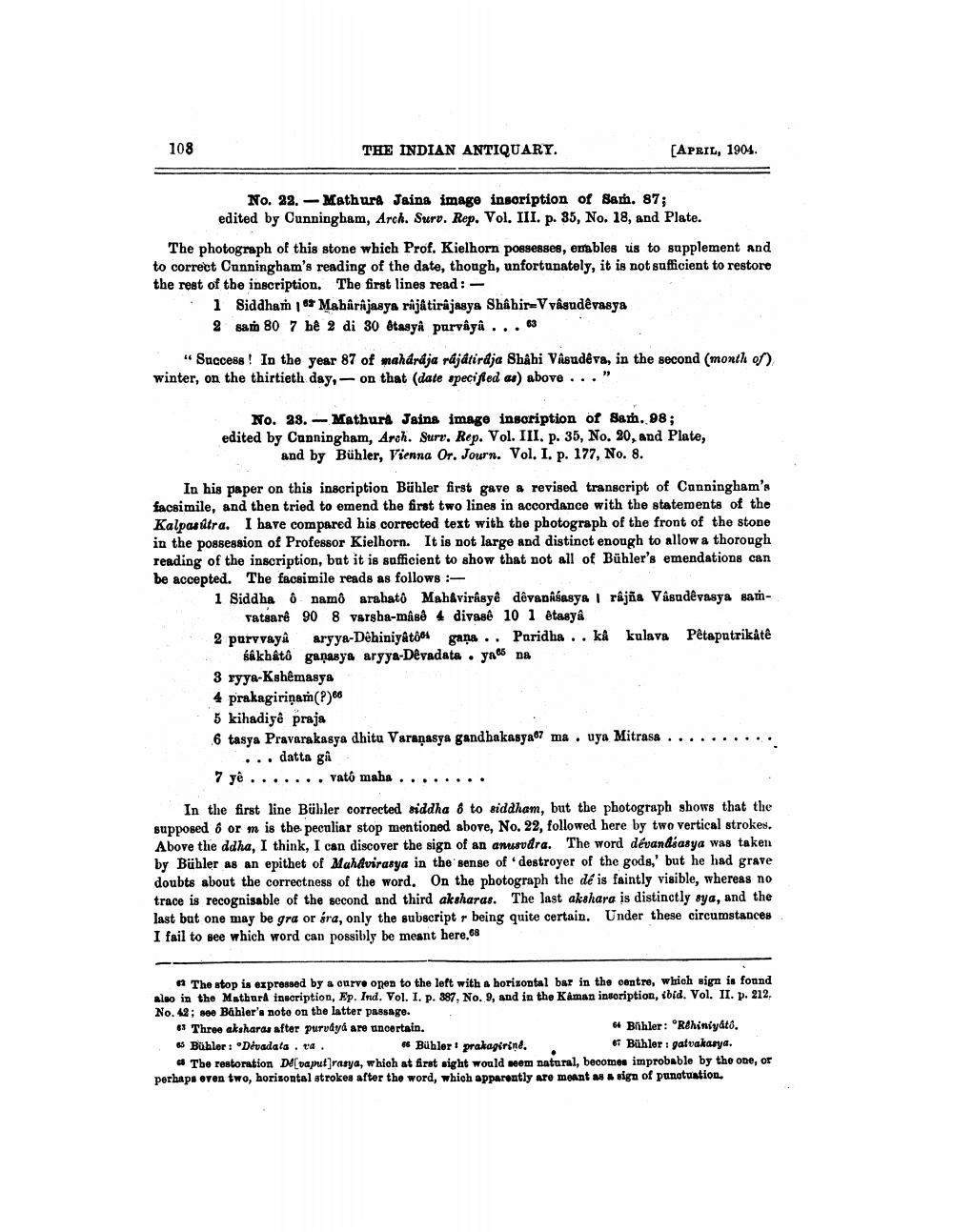________________
108
THE INDIAN ANTIQUARY.
[APRIL, 1904.
No. 22.-Mathura Jaina image insoription of San. 87; edited by Cunningham, Arch. Surv. Rep. Vol. III. p. 35, No. 18, and Plate.
The photograph of this stone which Prof. Kielhorn possesses, enables us to supplement and to correct Cunningham's reading of the date, though, unfortunately, it is not sufficient to restore the rest of the inscription. The first lines read: -
1 Siddham | Maharajasya rajatirajasya Shabir-V vasudêvasya 2 sam 80 7 hê 2 di 30 Otasyâ purvâyâ ...
"Success! In the year 87 of mahardja rájátirdja Shahi Vasudeva, in the second (month of) winter, on the thirtieth day, - on that (date specified as) above ..."
No. 28. -Mathura Jains image inscription of Samh. 98; edited by Cunningham, Arch. Surv. Rep. Vol. III. p. 35, No. 20, and Plate,
and by Bühler, Vienna Or. Journ. Vol. I. p. 177, No. 8.
In his paper on this inscription Bühler first gave a revised transcript of Canningham's facsimile, and then tried to emend the first two lines in accordance with the statements of the Kalpasitra. I have compared his corrected text with the photograph of the front of the stone in the possession of Professor Kielhorn. It is not large and distinct enough to allow a thorough reading of the inscription, but it is sufficient to show that not all of Bühler's emendations can be accepted. The facsimile reads as follows :
1 Siddha Ô damó araható Mahavirásyê dêvankšasya | rájia Vasudêvasya sa
vatsarê 90 8 varsha-mase 4 divasê 10 1 tasya 2 purvvayê aryya-Dehiniyatão gana .. Paridha .. kk kulava Pêtaputrikáte
sakható ganasys aryya-Devadata . ya na 3 ryye-Kshêmasya 4 prakagiriņam(?) 5 kihadige praja 6 tasya Pravarakasya dhitu Varaṇasya gandhakasya07 ma . uya Mitrasa .....
... datta gå 7 ye....... vató maha .......
In the first line Bühler corrected siddha 8 to siddham, but the photograph shows that the supposed 6 or m is the peculiar stop mentioned above, No. 22, followed here by two vertical strokes. Above the ddha, I think, I can discover the sign of an ansvdra. The word dévandsasya was taken by Bübler as an epithet of Mahavirasya in the sense of destroyer of the gods, but he had grave doubts about the correctness of the word. On the photograph the dé is faintly visible, whereas no trace is recognisable of the second and third aksharas. The last akshara is distinctly sya, and the last but one may be gra or ára, only the subscript - being quite certain. Under these circumstances I fail to see which word can possibly be meant here.68
The stop is expressed by a curve open to the left with a horizontal bar in the centre, which sign is found also in the Mathura inscription, Ep. Ind. Vol. I. p. 387, No. 9, and in the Kaman insoription, ibid. Vol. II. p. 212, No. 42; 100 Bahler's noto on the latter passage. 6* Three akshards after purvåyå are uncertain.
64 Bihler: "Réhiniyati, & Bühler: Devadata . ta.
# Bühler ! prakagirind,
6 Bühler: gatvakarya. The restoration De[papetrasya, which at first sight would seem natural, becomes improbable by the one, or perhaps even two, horizontal strokes after the word, which apparently are meant as a sign of punctuation.




